Onmyōdō
Onmyōdō (陰陽道, lit. 'Way of yin and yang') is a school of magic founded in Japan in the 5th-7th century, centering around the Chinese philosophy of the yin-yang and five elements (五行). While initially only used for divination (through reading the stars and calendars), the school developed other practices in areas such as medicine and exorcism.
Principles & Theories
Yin-Yang
The concept of yin-yang (陰陽, in'yō) is the concept of opposite and complementary halves interacting in harmony. The 'yin' part is negative, and the 'yang' part is positive. This dichotomy is seen in all part of nature. Yang is associated with the sun, the male, the active component, etc. Yin is associated with the moon, the female, the reactive component, etc. The little dot of the opposite color within each half represents the balancing acting of the two halves, whereby when one half reaches its peak or its lowest, the other surges to rectify the imbalance. In Taoist philosophy, the yin-yang duality is derived from the taiji (太極, lit. 'supreme ultimate'), the original state of the universe.
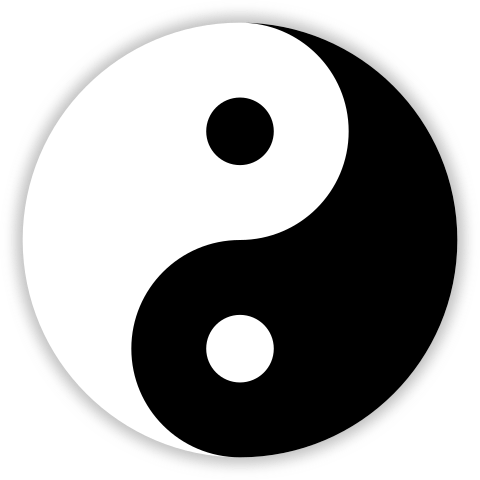
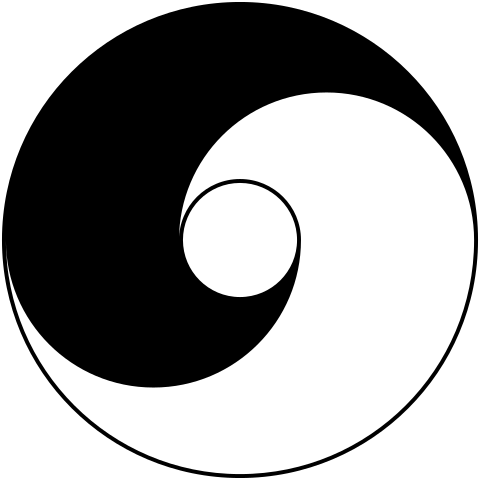
Five Elements
The five elements, also called the five phases, (五行, gogyō) is a concept of Chinese philosophy equally important to the yin-yang. Where the yin-yang describes the equal, opposite, and complementary interactions between two halves of a system, the five elements described the interaction of the five "agents" of nature: wood, fire, earth, metal, and water. There are five types of interactions: generating cycle (相生, sōjō), reverse generating cycle (相洩/相泄), destructive cycle (相剋, sōkoku), excessive destructive cycle (相乗, sōjō), and reverse/deficient destructive cycle (相侮, sōbu). Of these five, there are two cycles which forms the bases for the others: mutual generation (where one element leads to the formation of the another) and mutual destruction (where one element opposes the another). These two types of interactions can be seen in the diagram, where the generative interactions form a circle and the destructive interactions form a pentacle.
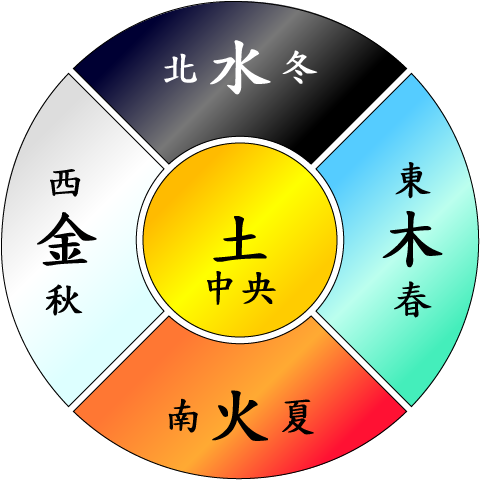
(Top, left-to-right) North, Water, Winter;
(Left, top-to-bottom) West, Metal, Fall;
(Right, top-to-bottom) East, Wood, Spring;
(Bottom, left-to-right) South, Fire, Summer;
(Center, top-to-bottom) Earth, Central authority
Kotodama
Kotodama (言霊, sometimes written as 言魂, lit. 'word spirit/soul')[1] refers to the form of magic which uses common language (typical one word or a short phrase) to perform magic. In English, this has been called the "power of words", "power of language", "magic words", or "divine words".
History
Onmyōdō (陰陽道) is a Japanese esoteric cosmology, a mixture of natural sciences and occultism. The practice, as the name implies, is based around the principles of yin and yang brought to Japan from mainland China. It is also influenced by other parts of Taoism, Buddhism, and the native Shintoism. After its inception in the late 7th century, onmyōdō became an acceptable system of divination and was under control of the imperial government.
In the 10th century, Kamo no Tadayuki (賀茂 忠行) and his son Kamo no Yasunori made great advances in onmyōdō. Among their students was the (now famous) Abe no Seimei, who inherited Tadayuki and Yasunori's knowledge of astronomy; Yasunori's son was trained in calendar-making instead.[2] Descendants of Seimei also studied onmyōdō, and the renown Tsuchimikado family arose from this lineage.
In addition to divination and calendar-making, onmyōji (陰陽師) were also trained to battle and exorcise monsters and demons. As an example, the onmyouji Abe no Yasuchika (安倍泰成) was asked to come and diagnose the cause of Emperor Toba’s (鳥羽院) illness, and through divination, he determined that the new courtesan Tamamo-no-Mae (玉藻の前) was actually a nine-tailed fox spirit. She had caused the downfall of kings in India and China, and was planning to do the same with him. Yasuchika set a trap for Tamamo, forcing her to reveal her true form and flee. The Emperor then sent two warriors Miura-no-suke and Kazusa-no-suke to pursue to the plains of Nasuno (present day Tochigi Prefecture) where she was killed. Her spirit is said to now inhabit a rock called the Shesshouseki (殺生石, killing stone) that leaks poisonous gas and kills any creature that passes by.[3] Then, in the Nanbuko-chou Period (1336-1392), Buddhist monk Gennō Shinshō (源翁心昭) destroyed the stone and exorcised the spirit by holding a ritual, allowing it to rest in peace.[4]
Practices
Equipments
Traditional Onmyōdō practices use paper talismans/charms (御札, ofuda) to cast their spells and special wooden boards (式盤, shikiban) for divination.
Spells
Onmyōdō spells are usually cast with the use of paper talismans or charms. As with other schools of magic, the type of phenomena that can be created using Onmyōdō spells is pretty wide-encompassing. Like Taoist magic, there are specific techniques/spells developed explicitly for exorcism. These are effective against yōkai as well as spirits, which means that Onmyōdō spells can affect the physical and/or spiritual matter.
Examples of Onmyōdō spells:
- Five Element Mutual Generation (五行相生, Gogyōsōjō)
- Wood feeds Fire (木生火, mokushōka)
- Fire creates Earth (火生土, kashōtsuchi)
- Earth bears Metal (土生金, dochishōkin)
- Metal enriches Water (金生水, kinshōmizu)
- Water nourishes Wood (水生木, mizushōmoku)
- Five Element Mutual Destruction (五行相剋, Gogyōsōkoku)
- Wood parts Earth (木剋土, mokkokudo)
- Earth dams Water (土剋水, dokokumizu)
- Water extinguish Fire (水剋火, mizukokuka)
- Fire melts Metal (火剋金, kakokukin)
- Metal chops Wood (金剋木, kinkokumoku)
- Six-fold Mist (六重霞, muegasumi)
Rituals
Rituals in Onmyōdō are complex spells that require more than paper talismans or a divination board. These are often seen for healing purposes or extraction of spirits from a possessed individual.
Related Articles
References
- ^ Kotodama - Wikipedia. https://en.wikipedia.org/wiki/Kotodama
- ^ Onmyōdō - Wikipedia. https://en.wikipedia.org/wiki/Onmy%C5%8Dd%C5%8D
- ^ Ferguson, Ian Stuart. (2012). The Evolution of a Legend—A Comparison of the Character of Tamamo no mae Portrayed in Muromachi Period Otogizōshi and in the Late-Edo Vendetta Tale, Itoguruma kyūbi no kitsune (The Spinning Wheel and the Nine-Tailed Fox). [Masters Thesis]. University of Colorado Boulder. https://scholar.colorado.edu/concern/graduate_thesis_or_dissertations/s1784k99j
- ^ Tamamo-no-Mae - Wikipedia. https://en.wikipedia.org/wiki/Tamamo-no-Mae
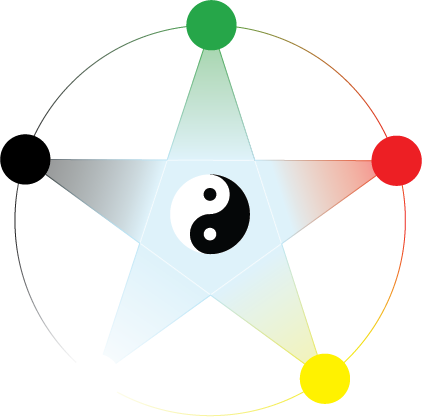
Onmyōdō
Kamo no Yasunori (賀茂 保憲)
Abe no Seimei (安倍 晴明)
Ashiya Dōman (蘆屋 道満)
Abe no Yasuchika (安倍 泰成)
The Black Reaper
Natsuo Tsuchimikado (土御門 夏雄)

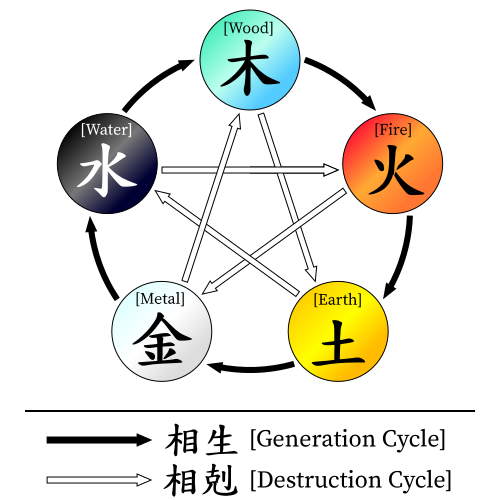

Comments